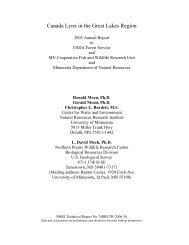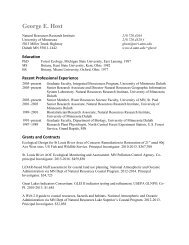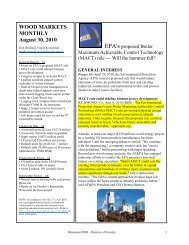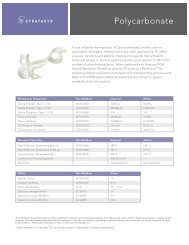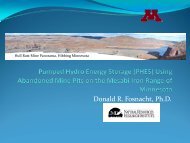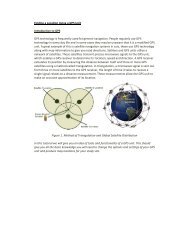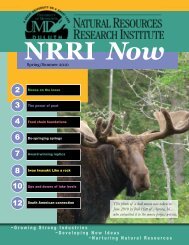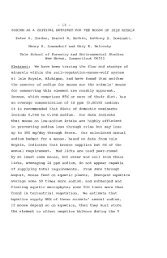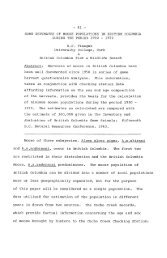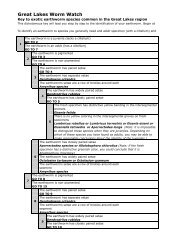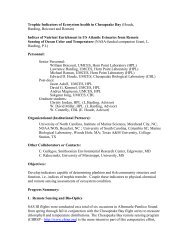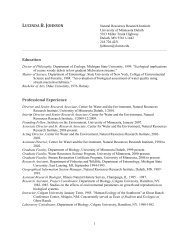Rapid Invasion of a Great Lakes Coastal Wetland by Non ... - BioOne
Rapid Invasion of a Great Lakes Coastal Wetland by Non ... - BioOne
Rapid Invasion of a Great Lakes Coastal Wetland by Non ... - BioOne
Create successful ePaper yourself
Turn your PDF publications into a flip-book with our unique Google optimized e-Paper software.
270 Tulbure et al.stall 2003). For example, Lynch and Saltonstall(2002) documented the expansion <strong>of</strong> the nativePhragmites genotype at a Lake Superior wetland.<strong>Coastal</strong> wetlands along Lake Michigan’s GreenBay are known to be dynamic, experiencing vastchanges in the extent <strong>of</strong> emergent vegetation aswater levels fluctuate over decadal cycles (Epsteinet al. 2002). Emergent plants germinate on lakebedexposed during low-water years, persist during averagewater level conditions, and decline after a series<strong>of</strong> high-water years, the marshes reverting toopen water (Harris et al. 1977, Bosley 1978). Typhais commonly mentioned as a key genus involved inthese vegetation cycles, but Phragmites is not.Data about plant species in wetlands <strong>of</strong> GreenBay on Lake Michigan were collected <strong>by</strong> the <strong>Great</strong><strong>Lakes</strong> Environmental Indicators project (GLEI)during mid-June 2001, when the water level <strong>of</strong>Lake Michigan was 54 cm below average (USCOE2006). During a repeat visit to wetlands <strong>of</strong> theGreen Bay area three years later, large stands <strong>of</strong>Phragmites were observed in the Point au Saublelagoon where little or no Phragmites had occurredin 2001. During the interim between the two sampledates, Lake Michigan experienced a prolonged period<strong>of</strong> below-average water levels.The goal <strong>of</strong> this paper is to document the rapidchange in wetland vegetation <strong>of</strong> a Green Bay lagoonover a 3-year period associated with the rapidinvasion <strong>of</strong> Phragmites. Specific objectives were tocompare vegetation structure and community compositionbefore and after Phragmites invasion, evaluateedaphic conditions within areas that were andwere not colonized <strong>by</strong> Phragmites, and determine ifthe expanding areas <strong>of</strong> Phragmites are <strong>of</strong> the invasivegenotype.METHODSStudy AreaThe 81 ha Point Au Sauble lagoon is located onthe eastern shore <strong>of</strong> Green Bay, 10 km northeast <strong>of</strong>the city <strong>of</strong> Green Bay in Brown County, Wisconsin.It is currently owned <strong>by</strong> the University <strong>of</strong> Wisconsin-GreenBay and has been preserved in a naturalstate <strong>by</strong> The Nature Conservancy and duck huntinggroups for many decades (UWGB C<strong>of</strong>rin Center forBiodiversity 2004). Point au Sauble is covered <strong>by</strong> avariety <strong>of</strong> plant communities such as floodplain forest,shrub-carr, sedge meadow, emergent aquatic,and <strong>Great</strong> <strong>Lakes</strong> beach, but the area sampled wasdescribed <strong>by</strong> earlier accounts as an open-water lagoon(Epstein et al. 2002). Although wetlands arecommon along the western shore <strong>of</strong> Green Bay,Point au Sauble is one <strong>of</strong> only a few coastal wetlandson the eastern shore <strong>of</strong> Green Bay.Abiotic Data CollectionThe soils at each plot were examined to a depth<strong>of</strong> 30 cm below the litter layer using a soil probe,and assigned to one <strong>of</strong> the following broad categories:organic, sand, silt, or clay. “Organic” soilswere those composed <strong>of</strong> organic soil material (peator muck) in a histic epipedon (Soil Survey Staff1999); undecomposed plant litter overlying the soilsurface was excluded when making this determination.Only the surface 30 cm was considered. Wedid not attempt to discern if soils in the organic categorywere true histosols. The texture <strong>of</strong> mineralsoils (i.e., sand, silt, clay) was determined <strong>by</strong> feelusing standard field methods (Soil Survey Staff1951). The hand texturing was done <strong>by</strong> co-authorJohnston, who is a pr<strong>of</strong>essional soil scientist certified<strong>by</strong> the American Society <strong>of</strong> Agronomy and experiencedat wetland soil characterization usingboth field and laboratory methods. Soil texture <strong>by</strong>plot in 2004 varied from silty to organic soils(Table 1).Lake level data recorded every 6 minutes atGreen Bay, Wisconsin (Station ID 9087079) wereobtained from the National Oceanic and AtmosphericAdministration (NOAA 2006), and were averagedover the time period from 0800 hours to1800 hours local standard time to determine averagewater levels on the days sampled. Monthly averageand monthly minimum lake levels, based ondata collected from 1918-2005, were obtained fromthe U.S. Army Corps <strong>of</strong> Engineers (USCOE 2006).Vegetation SamplingThe Point au Sauble lagoon was initially sampledon 19 Jun 01 as part <strong>of</strong> GLEI, a large, multi-investigatorproject designed to identify biotic indicators<strong>of</strong> human disturbance (Danz et al. 2005). The GLEIvegetation sampling protocol (Bourdaghs et al.2006, Johnston et al. 2007 this issue) was used inboth 2001 and 2004, when a repeat visit to the lagoonwas made on 7 Jul 04. A north-south trendingtransect was placed across the lagoon at Point auSauble, and 11 sampling locations (plots) were establishedat approximately 20 m intervals along thetransect (Fig. 1). At each sampling location, a 1 m 2plot was established and its geographic coordinates



